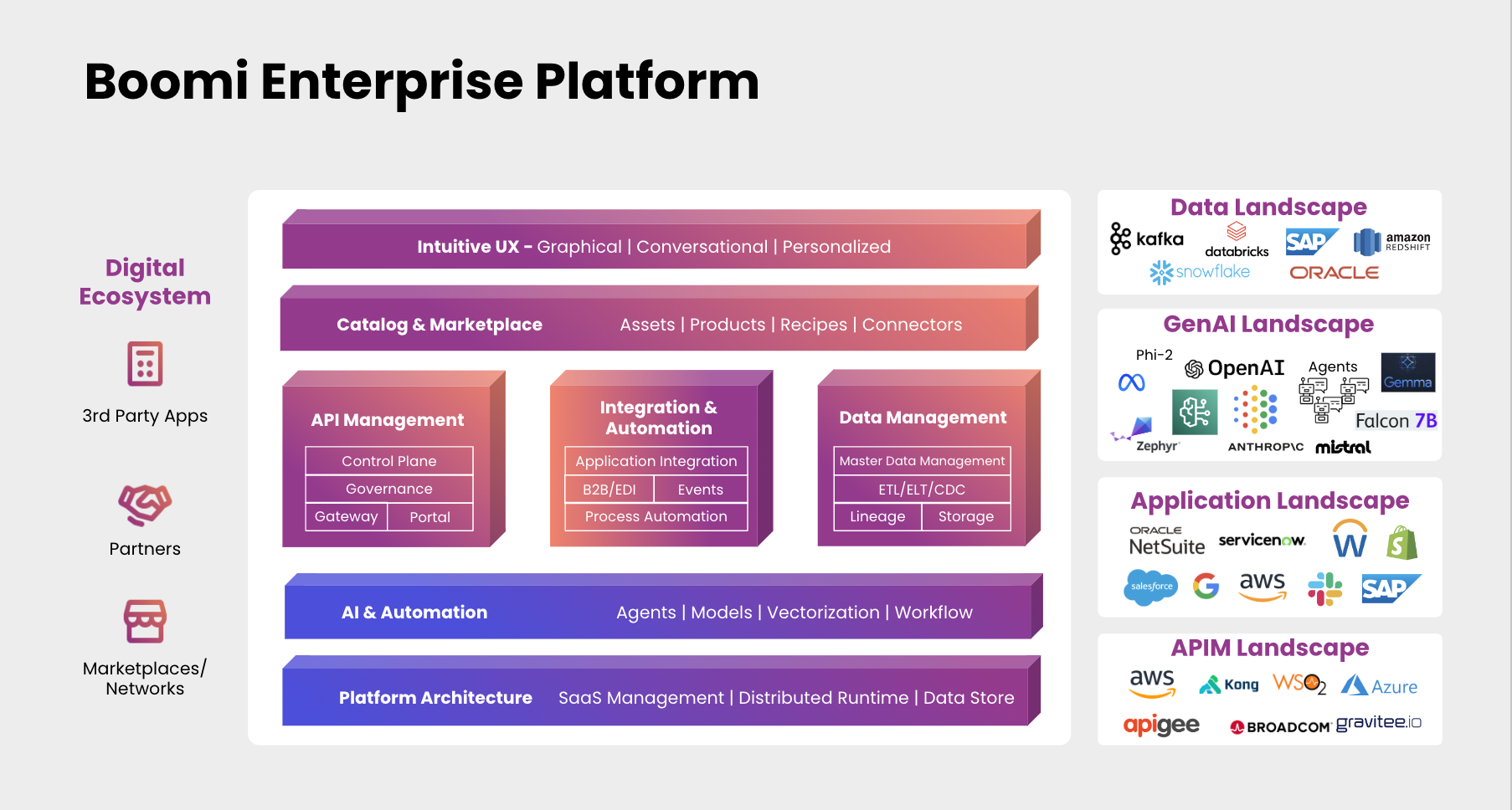The foundation of today’s interconnected digital landscape is data integration. Connecting disparate applications and systems enables businesses to streamline operations, enhance customer experiences, and rapidly scale to meet demand. One crucial technology that facilitates all this is API integration. In this post, we’ll explore API integration and common uses, showcasing real-world examples of how businesses leverage this technology to optimize their processes and achieve business goals.
What is an API?
An application programming interface (API) is a set of rules and protocols that allows different software applications to communicate with one another. It serves as a bridge, enabling data and functionality to be shared between systems, regardless of their underlying technologies or programming languages. APIs define how different software components should interact, specifying the types of requests and responses they can exchange.
What is API integration?
API integration refers to connecting multiple APIs to enable seamless data exchange and functionality sharing between different applications or systems. It allows businesses to create a unified ecosystem where software components work together harmoniously, eliminating silos and maximizing the value of each application.
The Business Case for API Integration
API integration plays a vital role in today’s digital business environment. It enhances operational efficiency and productivity by automating tasks, streamlining workflows, and eliminating manual data entry and synchronization. By integrating different systems, businesses can reduce errors, minimize duplication of efforts, and optimize resource allocation.
These API-powered integrations also enable businesses to deliver exceptional customer experiences. By integrating with third-party services and platforms, businesses can offer their customers a wide range of capabilities and features without reinventing the wheel.
Business API Integration Examples
1. Integrating Payment Gateways for Seamless Transactions
API integration allows businesses to connect their e-commerce platforms with payment gateways, streamlining the payment process for customers and merchants. With API integration, businesses can offer various payment options, including credit cards, digital wallets, and alternative payment methods.
By integrating payment gateways via APIs, customers can complete transactions without being redirected to external websites, resulting in a frictionless process that improves conversion rates. Additionally, API integration enables real-time payment authorization and status updates, reducing the risk of fraudulent activities and ensuring timely order processing.
2. Syncing Inventory and Order Management Systems
By integrating APIs between these systems, businesses can automate the data flow related to inventory updates, order placement, and order fulfillment.
When a customer places an order on the e-commerce platform, the API integration triggers the update of inventory levels in real-time, ensuring accurate stock availability. Simultaneously, the integration facilitates the transfer of order details from the e-commerce platform to the order management system, enabling efficient fulfillment.
This integration also empowers businesses to automate other critical tasks, such as generating shipping labels, tracking shipments, and updating customers with order status notifications.
3. Automated Social Media Posting and Content Sharing
Integrating with APIs of social media platforms, such as Facebook, Twitter, LinkedIn, and Instagram, enables businesses to schedule and publish posts automatically and share content to, ensure consistent messaging and brand presence.
API integrations can allow businesses to leverage third-party content management systems or marketing platforms. These platforms often offer advanced features for content creation, curation, and analytics.
4. Extracting Social Media Data for Targeted Advertising
Data is valuable in digital marketing, and social media platforms are rich user data sources. API integration allows businesses to extract social media data, such as user demographics, interests, and behavior. Businesses can identify users interacting with their content, segment them based on their preferences, and deliver tailored advertisements.
5. Integrating CRM Systems with Email Marketing Platforms
Businesses can automate various email marketing activities by integrating APIs of CRM systems and email marketing platforms. For instance, when a lead or customer’s status changes in the CRM system, the API integration triggers automated email campaigns. These campaigns can include welcome emails, onboarding sequences, personalized offers, or nurturing emails tailored to specific customer segments.
API integration also enables bidirectional data synchronization between the CRM and email marketing platforms. This synchronization ensures customer information, such as contact details, preferences, or purchase history, remains up-to-date in both systems.
6. Synchronizing Lead Generation and Customer Management
Businesses can automate the transfer of lead data by integrating APIs of lead generation tools, such as web forms, landing page builders, or live chat systems, with CRM systems. When a lead fills out a form or interacts with a live chat, the API integration ensures that the information is immediately captured in the CRM system. This automation eliminates manual data entry and reduces the risk of data loss or duplication.
Furthermore, API integration allows businesses to track and analyze the effectiveness of lead-generation efforts. Data on lead sources, conversion rates, and campaign performance can be seamlessly transferred to the CRM system. This integration provides valuable insights for sales teams, allowing them to prioritize leads, allocate resources effectively, and make data-driven decisions.
7. Integrating Project Management Tools for Streamlined Workflows
This enables businesses to synchronize project data, tasks, and timelines across different platforms. For example, when a task is created or updated in one project management tool, the API integration automatically reflects the changes in other integrated tools.
Businesses can integrate document management platforms, such as Google Drive or SharePoint, with project management tools and allow team members to directly access and collaborate on project-related files.
8. Syncing Calendar and Task Management Applications
Managing calendars and tasks is crucial for effective project management and team coordination. API integration enables businesses to synchronize calendar and task management applications, ensuring that team members stay organized, deadlines are met, and scheduling conflicts are minimized.
Any changes in the task management tool are reflected on the calendars in real time, keeping everyone informed and on track. This integration also allows for task assignments and updates. When something is assigned or modified in the task management tool, the API integration triggers notifications or updates in the calendar or collaboration tools.
9. Streamlining Operations with Smart Device Control
By integrating APIs of smart devices with mobile apps, businesses can streamline operations and enhance efficiency.
In retail and hospitality, API integration can connect smart point-of-sale (POS) systems, digital signage, and inventory management devices with mobile apps. This integration allows businesses to update pricing, manage inventory levels, and display targeted promotions or advertisements through the mobile app. By controlling these smart devices from a centralized mobile app, businesses can enhance customer experiences, ensure accurate inventory management, and drive sales.
10. Real-Time Monitoring and Control of IoT Devices
API integration enables real-time monitoring and control of IoT (Internet of Things) devices in various domains, such as industrial automation, healthcare, and logistics.
In healthcare, API integration can connect medical devices, wearables, and patient monitoring systems to healthcare applications. This integration facilitates real-time data sharing, allowing healthcare providers to monitor patient vitals, receive alerts, and provide timely interventions. API integration in healthcare enhances patient care, improves treatment outcomes, and enables remote patient monitoring.
Connect Your Vital Systems With API Integration From Boomi

API integration empowers businesses to create a unified ecosystem where different applications and systems work together seamlessly. It enhances operational efficiency, improves customer experiences, and provides valuable insights for decision-making. As businesses continue to embrace digital transformation, API integration will play an increasingly vital role in driving innovation and success.
Get started on your API-led strategy: Simplifying API led Connectivity With a Modern Integration Platform


 English
English 日本語
日本語